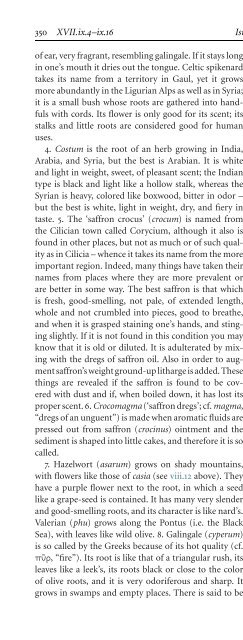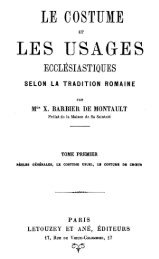The Etymologies of Isidore of Seville - Pot-pourri
The Etymologies of Isidore of Seville - Pot-pourri
The Etymologies of Isidore of Seville - Pot-pourri
Create successful ePaper yourself
Turn your PDF publications into a flip-book with our unique Google optimized e-Paper software.
350 XVII.ix.4–ix.16 <strong>Isidore</strong> <strong>of</strong> <strong>Seville</strong><br />
<strong>of</strong> ear, very fragrant, resembling galingale. If it stays long<br />
in one’s mouth it dries out the tongue. Celtic spikenard<br />
takes its name from a territory in Gaul, yet it grows<br />
more abundantly in the Ligurian Alps as well as in Syria;<br />
it is a small bush whose roots are gathered into handfuls<br />
with cords. Its flower is only good for its scent; its<br />
stalks and little roots are considered good for human<br />
uses.<br />
4. Costum is the root <strong>of</strong> an herb growing in India,<br />
Arabia, and Syria, but the best is Arabian. It is white<br />
and light in weight, sweet, <strong>of</strong> pleasant scent; the Indian<br />
type is black and light like a hollow stalk, whereas the<br />
Syrian is heavy, colored like boxwood, bitter in odor –<br />
but the best is white, light in weight, dry, and fiery in<br />
taste. 5. <strong>The</strong> ‘saffron crocus’ (crocum) isnamedfrom<br />
the Cilician town called Corycium, although it also is<br />
found in other places, but not as much or <strong>of</strong> such quality<br />
as in Cilicia – whence it takes its name from the more<br />
important region. Indeed, many things have taken their<br />
names from places where they are more prevalent or<br />
are better in some way. <strong>The</strong> best saffron is that which<br />
is fresh, good-smelling, not pale, <strong>of</strong> extended length,<br />
whole and not crumbled into pieces, good to breathe,<br />
and when it is grasped staining one’s hands, and stinging<br />
slightly. If it is not found in this condition you may<br />
know that it is old or diluted. Itisadulterated by mixing<br />
with the dregs <strong>of</strong> saffron oil. Also in order to augment<br />
saffron’s weight ground-up litharge is added. <strong>The</strong>se<br />
things are revealed if the saffron is found to be covered<br />
with dust and if, when boiled down, it has lost its<br />
proper scent. 6. Crocomagma (‘saffron dregs’; cf. magma,<br />
“dregs <strong>of</strong> an unguent”) is made when aromatic fluids are<br />
pressed out from saffron (crocinus) ointmentandthe<br />
sediment is shaped into little cakes, and therefore it is so<br />
called.<br />
7. Hazelwort (asarum) grows on shady mountains,<br />
with flowers like those <strong>of</strong> casia (see viii.12 above). <strong>The</strong>y<br />
have a purple flower next to the root, in which a seed<br />
like a grape-seed is contained. It has many very slender<br />
and good-smelling roots, and its character is like nard’s.<br />
Valerian (phu) grows along the Pontus (i.e. the Black<br />
Sea), with leaves like wild olive. 8. Galingale (cyperum)<br />
is so called by the Greeks because <strong>of</strong> its hot quality (cf.<br />
, “fire”). Its root is like that <strong>of</strong> a triangular rush, its<br />
leaves like a leek’s, its roots black or close to the color<br />
<strong>of</strong> olive roots, and it is very odoriferous and sharp. It<br />
grows inswamps and empty places. <strong>The</strong>re is said to be<br />
another species <strong>of</strong> galingale that grows in India and is<br />
called zinziber (“ginger”) in their language.<br />
9. <strong>The</strong>Illyrian iris (iris) tookitsname from its likeness<br />
to the heavenly Iris (i.e. the rainbow). For this reason<br />
Latin speakers call it arcumen, because its flower, in its<br />
variety <strong>of</strong> color, imitates that heavenly bow (arcus). It is<br />
called Illyrian because it is most abundant and fragrant<br />
in Illyria. In appearance it has leaves like the gladiolus,<br />
and it has an aromatic root that is good-smelling. 10. Acorum<br />
(perhaps ‘sweet flag’) has leaves similar to the iris,<br />
and roots <strong>of</strong> a very sharp but pleasant scent, for which<br />
reason it is also a spice. Meu ...Cardamom (Cardamomum)...11.<strong>The</strong>squinum<br />
(i.e. schoenum,akind <strong>of</strong> rush)<br />
that grows at the Euphrates is better than that in Arabia,<br />
tan-colored, abounding in flowers, purple, slender;<br />
it smells like a rose when it is crumbled in one’s hands,<br />
and when tasted it is fiery and biting on the tongue.<br />
Its flower is called (“flower <strong>of</strong> rush”),<br />
for ‘flower’ is in Greek (cf. , “rush”). 12.<br />
Thyme (thymum) issocalled because its flower gives<br />
<strong>of</strong>f a fragrance (cf. ,“<strong>of</strong>fer by burning”; “to<br />
burn incense”). About this, Vergil (Geo. 4.169):<br />
<strong>The</strong> fragrant honey smells <strong>of</strong> thyme (thymum).<br />
13. Epithymum (i.e. a parasitic plant growing on<br />
thyme) is a Greek name, which in Latin is called ‘flower<br />
<strong>of</strong> the thyme’ (flos thymi), for the thyme flower in Greek<br />
is (and cf. , “upon”).Itisaflower resembling<br />
‘Cretan thyme’ (thymbra).<br />
14.Marjoram (sampsuchus), which Latin speakers call<br />
amaracus, aname that Vergil uses to refer to Venus (cf.<br />
Aen. 1.693):<br />
Where the s<strong>of</strong>t marjoram (amaracus), embraces him<br />
with shade.<br />
This herb is good for perfumes. It took its name from<br />
the page <strong>of</strong> a certain king who, having accidentally fallen<br />
when he was carrying perfumes, created a new and very<br />
pleasant scent from their mixing together. 15. Hyacinth<br />
(hyacinthus) isaplant that has a purple flower. It took<br />
its name from a certain noble boy who was found killed<br />
in a glade among purple flowers; the misfortune <strong>of</strong> this<br />
child’s death gave its name to the plant. In root and flower<br />
it resembles an onion, and it delays puberty in boys.<br />
16. <strong>The</strong> plant narcissus (narcissus) hasaname given in<br />
the myth <strong>of</strong> a certain boy whose limbs were transformed<br />
into this flower. <strong>The</strong> flower both keeps Narcissus’s name

















